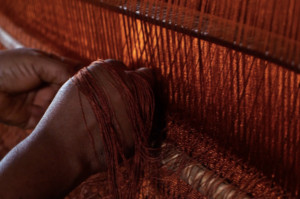
Iwájú (re)animates a longstanding curiosity in Lagos-centric sci-fi stories—What will the Lagos of the future look like? Through its world-building strategies, Iwájú demonstrates what Senegalese academic Felwine Sarr argues in Afrotopia, “The [Lagos] of tomorrow is in gestation within the [Lagos] of today, and its signs are decipherable within the present” (Sarr 2020). We can consider two pointers—an ongoing urban planning project and a computer-mediated fantasy—for clues about the dynamics Iwájú presses into the service of a future Lagos.
Eko Atlantic City stretches 7 kilometers and 2 kilometers wide along the Atlantic oceanfront in Victoria Island, Lagos. The billion-dollar project aims to solve real estate problems by promising housing, leisure, offices, and parks that will intensify Lagos’ transformation into a future megacity and bring it in close alignment with global capital. The coastal city’s location allows it to face two worlds, courting wealthy local elite and foreign investors across the Atlantic. It is a prime example of “city doubles,” Martin Murray’s (2015) term for built-from-scratch, self-contained corporate cities springing up across Africa.

The second pointer is a viral video from the 2020 global pandemic lockdown. In the short video posted on social media, a drone delivers a carton of noodles to Uche Anisiuba at his Lagos residence. In the sequence, the drone dispenses a point-of-sale (or POS) machine on which Anisiuba swipes to pay for the service. Besides being a fake, part of this video’s intrigue is another future curiosity: Will there be a time when drones will deliver packages to doorsteps in Lagos? (Compare Amazon Drone Delivery Services).
Iwájú anticipates these imagined scenarios in its architectural language as well as its strangely familiar technologies of mobility. Beyond the fascinating characters, voice acting, lively color keys that set the story’s emotional tone, Ré Olunuga’s enchanting scores, and the culturally situated items that local audiences can relate to—the agbada, puff puff, zobo—what can we learn from how the visual world of Iwaju is built and executed? I offer two observations.
First, the animation advances Sci-fi as an African form. Its flying cars, smart homes, intelligent robots, flying tricycles, and drone carts are not mere add-ons. They are futuristic technologies that embody the social and urban energies of the known Lagos. Iwájú appropriates the sci-fi genre and its leitmotifs, not simply for aesthetic compliance, but as an active tool for thinking about alternative worlds and sensibilities in postcolonial futures. In imagining alternative futures to current realities, the series becomes a conscious speculation, a fiction that coopts the real. When Uganda artist and production designer on Iwájú, Hamid Ibrahim said “We didn’t take on tropes of science fiction for the sake of incorporating flying cars into the narrative,” he is reiterating what Ainehi Edoro asserts about Nnedi Okorafor’s Lagoon. Iwájú “isn’t merely Sci-fi with an African flavor… It is a bold, new reinvention of science fiction as a bonafide African form” (Ainehi 2015). We can read Iwaju‘s flying cars and tricycles as imagined responses to Lagos’ notorious traffic.
Second, vertical logic guides the spatial orientation of Iwájú‘s Lagos. The show retains the unique geography where a body of water naturally separates Tola’s affluent area of Lagos Victoria Island from Kole’s congested and densely populated Lagos Mainland. Whereas Victoria Island has an elastic topography—as with Eko Atlantic, land can be reclaimed from water—the Mainland must adopt innovative ways to cope with overpopulation. As a result, buildings on the Mainland are taller, and spatial interactions proceed along the y-axis. On his way to Bode, the leader of a kidnapping ring, Kole hails a Keke (tricycle) and points upwards before the automobile lifts off. Architectural designs by concept artists like Godwin Akpan depict Mainland’s high-rise structures as stacked containers clustered together. In addition to its audacious attitude, the Lagos of tomorrow rises in altitude, gesturing to the extent to which its lands have been exploited. In Iwájú, vehicles, tricycles, drones, and planes converge to evolve a third space in the lower altitudes of the future Lagos.
Kugali co-founders Olufikayo Adeola, Tolu Olowofoyeku, and Hamid Ibrahim describe Iwájú as a “love letter” to Lagos. We must take the production as a visual homage and manifesto for African future probabilities. Samuel Delaney has distinguished realism, fantasy, and science fiction. For Delaney, while realism deals with what could have happened, and fantasy with what could not have happened, sci-fi describes what has not happened yet (Delaney pp. 10-11). Kugali Media and Disney’s Iwájú, a first on many fronts, shuttles between these three categories but etch in our minds what is yet to be. If we follow Delaney that Iwájú is an African sci-fi that speaks of what might be—but may not—if we accept its African future probabilities, then the social and infrastructural divides displayed in the visual narratives would become codes with which we can deeply appraise the politics of space, class, gender and other vectors that structure our postcolonial existence.
References
Edoro, A. (2015). “Aliens in Lagos.” Africa is a Country. Retrieved from https://africasacountry.com/2015/07/the-futuristic-lagos-of-nnedi-okorafors-lagoon
Delaney, S. (2009). “About 5,750 Words.” In R. Latham (Ed.). Science Fiction Criticism: An Anthology of Essential Writings (pp. 104-114). Bloomsbury.
Murray, J. M. (2020). “City Doubles: Re-urbanism in Africa.” In F. Miraftab et al (Eds.). Cities and Inequalities in a Global and Neoliberal World (pp. 92-109). London: Routledge.
Sarantopoulos, C. (2024). “Meet the Characters of Disney Animation’s Iwaju.” D23. Retrieved from https://d23.com/meet-the-characters-of-disney-animations-iwaju/.
Sarr, F. (2020). Afrotopia. Minnesota: University of Minnesota Press.










COMMENTS -
Reader Interactions